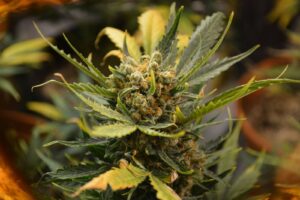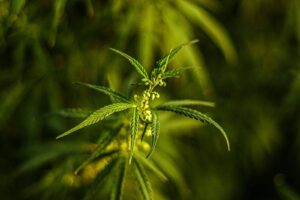Have you ever checked your cannabis buds only to find them covered in a strange fuzzy coating? Bud mold is a grower’s worst nightmare, and it can ruin an entire harvest if you do not catch it early. Moldy cannabis is not just unsellable, but it can also pose serious health risks. It spreads quickly, and once mold takes hold, the affected buds cannot be saved.
Mold can spread through spores that travel easily in the air. Once a bud is infected, the spores can land on nearby plants, creating a chain reaction of contamination. This is why early detection and swift removal of moldy buds are critical. If left unchecked, mold can compromise not just individual plants but entire grow rooms or outdoor plots, leading to significant financial losses.
Understanding how to identify, prevent, and handle bud mold is essential for protecting your crop. This article covers the key signs of mold, how to distinguish it from trichomes, the health risks associated with mold exposure, and the conditions that encourage its growth. You will also learn preventive strategies for both indoor and outdoor growth and what to do if mold appears on your plants.
Identifying Bud Mold in Cannabis
Bud mold, or Botrytis cinerea, is one of the biggest threats to a healthy cannabis crop. It spreads quickly, often hiding deep inside dense buds where it’s hard to spot until it’s too late. Once it takes hold, it can ruin your harvest. The key to preventing major damage is early detection. Knowing exactly what to look for, you can catch mold before it spreads and protect your plants. Here’s how to identify the warning signs.
Key Signs of Bud Mold
- Gray or White Fuzzy Growth: A cotton-like or powdery substance on buds is a clear indicator.
- Dark or Discolored Spots: Brown, black, or gray patches signal decay and mold infiltration.
- Musty or Earthy Smell: Mold often gives off a damp, mildew-like odor before becoming visible.
- Brittle or Wilting Buds: Affected buds may crumble, collapse, or feel unusually soft and spongy.
- Spore Dust: If you tap a bud and see a fine, smoky dust release, those are mold spores.
- Silk-Like Webbing: Some mold strains produce a fine, spiderweb-like structure on buds.
- Unusual Resin Texture: Mold can make trichomes appear dull, clumpy, or sticky in an unnatural way.
- Yellowing Leaves Near Bud Sites: Nearby leaves may droop or discolor due to mold stress.
Where Mold Hides
Mold thrives in places where moisture lingers. Be sure to inspect:
- Inside Dense Colas: Thick buds trap humidity, making them a prime target.
- Undersides of Sugar Leaves: Mold can start here before spreading inward.
- At Stem and Bud Connection Points: Tight crevices are ideal hiding spots for mold.
- Near Wounds or Cuts: Mold thrives on damaged plant tissue.
- In Drying and Curing Areas: Mold can develop post-harvest if humidity isn’t controlled.
Early Warning Signs in Your Grow Space
- Condensation on Walls or Tent Surfaces: Persistent moisture means buds are also at risk.
- Damp or Musty Smell in the Air: Sometimes, mold is noticeable by scent before it’s visible.
- Overly Humid Conditions: High humidity (above 50%) and poor airflow create the perfect environment for mold growth.
So, how do you tell the difference between trichomes and mold? Here’s how you identify them.
Trichomes vs. Mold: How to Tell the Difference
Trichomes are tiny, crystal-like structures on cannabis buds that produce cannabinoids and terpenes, enhancing potency and aroma. Mold, on the other hand, is a harmful fungal growth caused by excess moisture, which can ruin cannabis and pose health risks. Since both can appear as a coating on buds, knowing how to tell them apart is essential for safety and quality.
The table below highlights the key differences:
Feature | Trichomes | Mold |
Color | Clear, milky, or amber with a crystalline look | White, gray, yellow, or green in irregular patches |
Growth Pattern | Evenly coats the bud like frost | Grows in scattered spots and spreads unevenly |
Reaction to Light | Sparkles or glistens under light | Dull or powdery appearance |
Texture | Sticky and resinous | Dry, slimy, or spongy |
Smell | Strong, natural cannabis aroma | Musty, stale, or ammonia-like odor |
Effect on Bud | Enhances potency and quality | Makes buds damp, brittle, or crumbly |
Health Impact | Safe to consume | It can cause respiratory issues, allergic reactions, or infections |
If you’re unsure, it’s safer to discard the bud. Moldy cannabis is dangerous, while healthy trichomes indicate quality. Store your cannabis in a cool, dry, airtight container to prevent mold growth.
High-Risk Conditions for Mold Development
Your plants could become the perfect breeding ground if you’re not careful. Here’s what to watch out for:
- High Humidity Levels: Mold loves humidity above 60%. If your grow space lacks proper humidity control, mold spores will settle and spread fast.
- Poor Air Circulation: Stagnant air allows moisture to build up. Mold can take hold in dense foliage without proper airflow from fans, intake vents, or oscillating systems.
- Warm, Dark Spaces: Mold thrives between 77 and 86°F (25 to 30°C). If your grow room gets too warm and lacks light penetration, mold has an open invitation.
- Overwatering: Excess moisture in the growing medium can create the perfect conditions for mold, especially in soil or coco coir that stays damp for too long. PlanaCan helps growers track irrigation schedules, plan ahead, and adjust tasks as needed. Centralizing information ensures everyone stays on the same page, reducing oversights and maintaining optimal conditions.
- Neglected Water Damage: Standing water from leaks, spills, or condensation can seep into walls, floors, and plant containers, leading to hidden mold growth.
- Clogged Drainage Systems: Poor drainage in pots or hydroponic setups can cause water buildup, increasing humidity and mold risk around the roots.
- Dense Canopy Growth: Overcrowded plants create humid microclimates where air can’t circulate properly, trapping moisture and encouraging mold development.
- Unclean Grow Equipment: Fans, filters, and ductwork can collect dust and moisture, providing an ideal environment for mold if not cleaned regularly.
- Stored Supplies in Humid Areas: Bags of soil, nutrients, or unused plant material stored in humid conditions can develop mold and contaminate your grow.
- Lack of Proper Exhaust and Dehumidification: If your ventilation system isn’t removing excess humidity effectively, mold will thrive. Proper dehumidifiers and exhaust fans are essential.
To prevent mold, control humidity, maintain airflow, and clean your equipment regularly. A proactive approach can save you from losing your crop to contamination. PlanaCan helps by capturing data on cultivation decisions and their impact on yield, making it easier to track what works and what doesn’t. With detailed harvest reports in one place, growers can analyze trends, refine processes, and continuously improve profitability.
Now, let’s examine some of the preventive measures you can take to avoid mold development in your indoor cannabis setup.
Preventive Measures in Indoor Environments
Mold thrives in damp, humid conditions, and once it appears, it spreads fast. But you can stop it before it starts. You can keep your indoor spaces mold-free by controlling moisture, improving ventilation, and staying proactive. Here’s what you need to do.
- Control Humidity Levels: Keep indoor humidity below 50%. Use a dehumidifier or air conditioner, especially in damp areas like basements and bathrooms. A hygrometer can help you monitor moisture levels.
- Ensure Proper Ventilation: Use exhaust fans in the kitchen and bathroom to increase airflow. Open windows whenever possible to improve air circulation.
- Fix Leaks Immediately: Inspect pipes, roofs, and windows regularly. Address any signs of leaks immediately to prevent moisture buildup.
- Dry Wet Areas Promptly: Mold can grow within 24-48 hours on wet surfaces. Dry the area immediately if you experience spills, flooding, or excess condensation.
- Use Mold-Resistant Materials: If you’re renovating or building, consider mold-resistant drywall, paint, and insulation—especially in moisture-prone areas.
- Keep Surfaces Clean: Regularly clean and disinfect surfaces prone to mold, such as bathroom tiles and kitchen sinks. Vinegar or hydrogen peroxide can help prevent mold growth.
- Store Items Properly: Avoid storing paper, clothing, or wood in damp areas like basements or attics. Use moisture-proof containers when necessary.
Now, let us examine the same for the outdoor setup of your cannabis crop.
Handling Mold-Infested Cannabis
If you want to protect your crop and avoid costly losses, you need to act fast and put the right prevention measures in place. Here’s how to handle mold-infested cannabis and stop it from coming back.
1. Identify Mold Before It Spreads
Mold usually shows up as fuzzy white, gray, or black spots, often with a musty smell. It thrives in humid, stagnant conditions and can spread quickly. Don’t mistake it for trichomes. Use a magnifying glass or a blacklight to confirm.
2. Remove and Destroy Affected Buds
There is no saving moldy cannabis. Remove all contaminated buds immediately, including those nearby. Never try to dry, cure, or extract anything from moldy plants. Smoking or consuming mold can cause serious respiratory issues.
3. Inspect Your Grow Room
Mold spores don’t just stay on plants. They linger in your grow space. Check walls, fans, filters, and any surfaces where moisture accumulates. If you see signs of mold in your environment, it’s time for a deep clean.
4. Clean and Disinfect Everything
After removing infected buds, disinfect your grow room, tools, and storage containers. Use hydrogen peroxide or diluted bleach solution to kill lingering spores. Consider replacing carbon filters if they have been exposed to mold.
5. Control Humidity and Airflow
Mold thrives in humid, stagnant air. To prevent future outbreaks:
- Keep humidity between 45 and 55 percent during flowering
- Use oscillating fans to improve airflow
- Ventilate with an exhaust system to remove excess moisture
- Avoid temperature spikes that cause condensation
6. Space and Prune Plants for Better Airflow
Overcrowded plants create pockets of trapped moisture, which are perfect for mold growth. Regular pruning, low-stress training (LST), and proper spacing help reduce the risk. If your canopy is too dense, thin it out.
7. Use Preventative Organic Treatments
Beneficial microbes like Trichoderma and Bacillus subtilis can help protect plants from mold. Some growers also use diluted hydrogen peroxide or neem oil as a preventative spray during early vegetative growth.
8. Dry and Cure Properly
Even if your plants stay mold-free during growth, mistakes in drying and curing can ruin them. Dry buds slowly at 60°F (15°C) and 55 percent humidity. Then cure in airtight glass jars with humidity packs to prevent excess moisture buildup.
9. Monitor Conditions with a Hygrometer
A digital hygrometer and thermometer let you track humidity and temperature in real time. Adjust your dehumidifier, fans, or ventilation if you see spikes. PlanaCan helps growers take this a step further by generating detailed reports for each harvest, tracking how environmental factors impact yield. With all data in one place, it’s easier to analyze trends, refine techniques, and improve profitability over time.
Conclusion
Bud mold can destroy an entire harvest if you are not careful. Regular inspections help catch early signs, and proper environmental control is essential for prevention. Whether you are growing indoors or outdoors, taking steps to manage humidity and airflow can save you from major losses.
Moldy cannabis is not just a waste of time and money, it is a serious health hazard. The best approach is to stay proactive. Spot the signs early, implement strong prevention strategies, and never take risks with contaminated buds. Your health and your harvest depend on it.
Managing a cannabis grow operation requires attention to detail, and tools like PlanaCan make it easier to stay on top of every step. It allows you to define and streamline cultivation processes using customizable templates.
From planting to harvesting, PlanaCan helps you set up a consistent and efficient workflow. It also allows you to plan months ahead while keeping track of daily tasks, ensuring no crucial step is overlooked. PlanaCan helps you maximize yields and maintain a healthy crop by centralizing your grow management.
Schedule a free call today to see how PlanaCan can simplify your cannabis cultivation process and improve your results.




